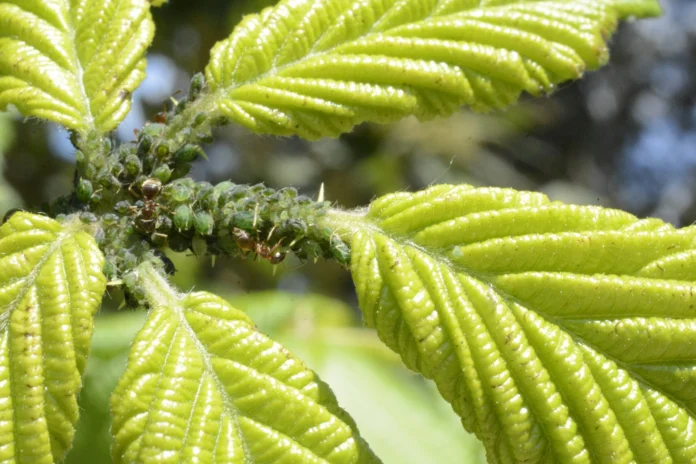Trees are essential to our landscapes, providing shade, beauty, and a vital habitat for wildlife. However, just like any living thing, trees can fall victim to pests—small but destructive insects and organisms that weaken or even kill them over time. Early identification and proper management are crucial in preventing lasting damage. In this post, we’ll explore some of the most common tree pests you should keep an eye out for and how to deal with them.
Table of Contents
1. Aphids
These tiny, soft-bodied insects are among the most widespread pests affecting trees. They gather on leaves and stems, sucking out sap and weakening the plant. While a few aphids might not be a problem, large colonies can cause leaves to curl, turn yellow, and drop prematurely. In addition, they excrete a sticky substance called honeydew, which can encourage the growth of sooty mold.
Signs of infestation:
- Sticky residue on leaves or ground
- Curling, yellowing leaves
- Presence of ants (they’re attracted to honeydew)
Solution: Spray the tree with water to knock aphids off. Introduce beneficial insects like ladybugs, or use insecticidal soap for more persistent infestations.
2. Japanese Beetles
These shiny, metallic green beetles are as beautiful as they are destructive. They feast on leaves, flowers, and fruit, skeletonizing foliage by eating the tissue between the leaf veins.
Signs of infestation:
- Lace-like, skeletonized leaves
- Visible adult beetles in clusters
- Damaged flowers and fruit
Solution: Handpick beetles in early morning and drop them into soapy water. Consider traps (placed far from trees) or neem oil to disrupt their life cycle.
3. Emerald Ash Borer (EAB)
A devastating pest, the Emerald Ash Borer has killed millions of ash trees across North America. The larvae burrow beneath the bark, disrupting the tree’s ability to transport nutrients and water.
Signs of infestation:
- Canopy dieback
- D-shaped exit holes in bark
- Vertical splits in bark
- Increased woodpecker activity
Solution: Insecticide treatments can be applied by professionals if caught early. In severe cases, removal of the infected tree may be necessary to prevent spread.
4. Tent Caterpillars
Often seen in spring, these caterpillars spin silk tents in the branches of trees and feed on leaves, sometimes defoliating trees entirely.
Signs of infestation:
- Large silk tents in tree forks
- Chewed and missing foliage
- Visible caterpillars crawling on branches and bark
Solution: Remove and destroy tents by hand in early morning or evening when caterpillars are inside. Prune out infested branches or use a targeted insecticide if necessary.
5. Scale Insects
Scale insects can look like small bumps on twigs and bark, making them easy to overlook. These pests feed on sap and can weaken or kill branches over time.
Signs of infestation:
- Sticky honeydew residue
- Leaf yellowing or premature drop
- Bumps on bark and stems that don’t move
Solution: Use horticultural oils or insecticidal soaps. For severe infestations, systemic insecticides may be required.
6. Bagworms
Bagworms construct protective cases out of silk and tree debris, hanging them from branches. The larvae feed on needles and leaves, which can severely defoliate trees, especially evergreens.
Signs of infestation:
- Hanging bags that look like pinecones or debris
- Thinning or browning foliage
- Leaf damage, particularly on evergreens
Solution: Remove bags by hand during fall or winter before larvae hatch. For active infestations, biological pesticides like Bacillus thuringiensis (Bt) are effective.
7. Spider Mites
While not insects (they’re arachnids), spider mites are serious tree pests, especially during hot, dry weather. They feed on plant cells and can cause stippling, leaf bronzing, and early leaf drop.
Signs of infestation:
- Tiny, discolored spots on leaves
- Fine webbing on undersides of leaves
- Leaves turning bronze or yellow
Solution: Increase humidity with regular watering. Spray with water to dislodge mites or use miticides if the infestation is heavy.
Protecting Your Trees
Prevention is the best defense. Here are some general tips to keep your trees healthy and resilient:
- Regular Inspection: Check your trees at least once a month for signs of pests or disease.
- Healthy Soil: Mulch and fertilize as needed to promote robust growth.
- Pruning: Remove dead or diseased branches to prevent pest harborage.
- Water Wisely: Water deeply during dry spells to reduce stress, which makes trees more vulnerable to pests.
- Invite Beneficial Insects: Encourage natural predators like ladybugs, lacewings, and birds.
Also Read : 6 Supportive Solutions for Aging in Place
Final Thoughts
While pests are a natural part of any ecosystem, unchecked infestations can cause long-term damage to your landscape. By learning to identify these “usual suspects” early, you can protect your trees and ensure they continue to thrive for years to come.
If you’re unsure about a pest problem or the best treatment, don’t hesitate to consult a certified arborist in Salt Lake City, Utah. When it comes to tree health, proactive care always pays off.
